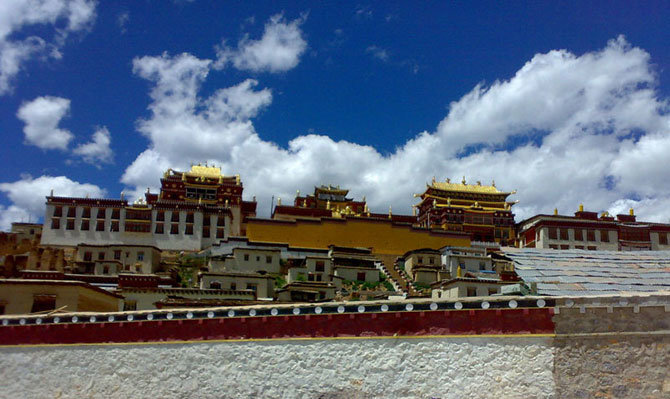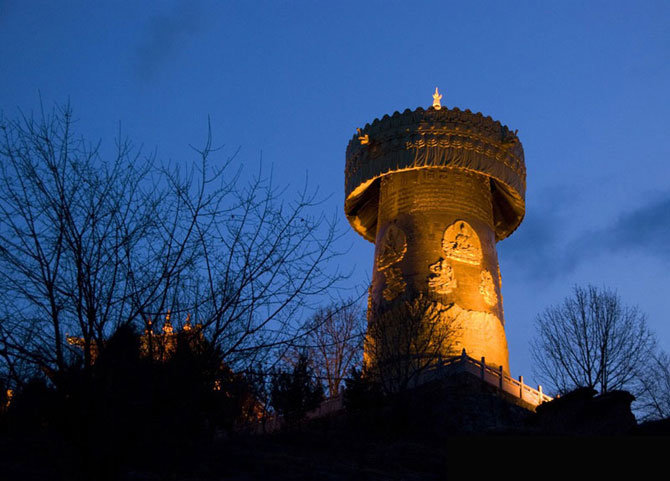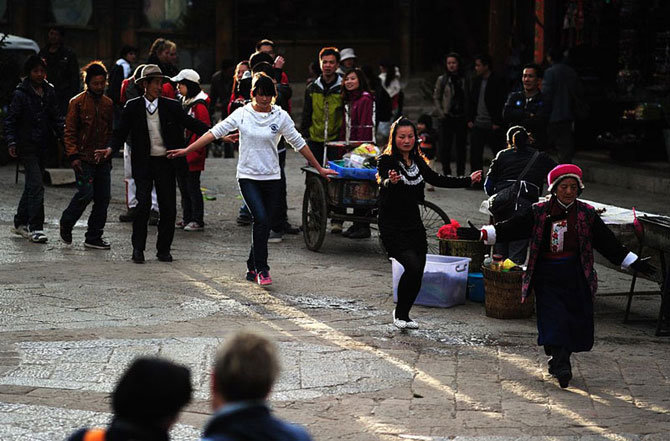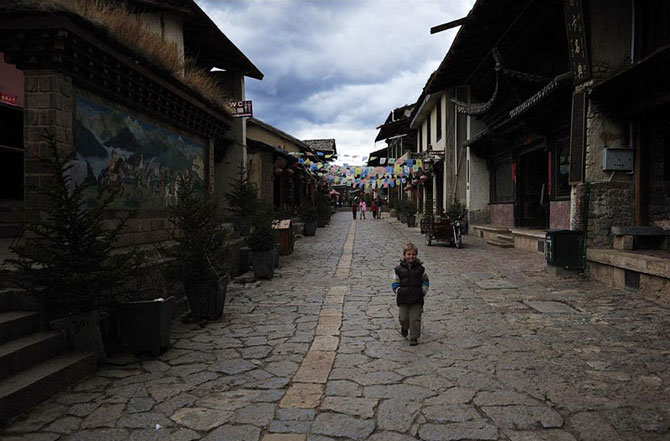
11. January 2014: A fire broke out in Dukezong and destroyed the ancient city centre. Please find more information about the blaze here. In the meanwhile, the Old Town has been largely restored again. For travel impacts and alternative trips in and around Shangri La please contact us directly.
Text and pictures about Dukezong Ancient Village below are not completely up to date anymore but shall still serve as a general impression. All other travel destinations mentioned in this article (nearby monasteries, mountains and lakes) have not been impacted by this incident.
Shangri-La, the former Zhongdian, mainly consists of two areas split by a street: Dukezong old town to the south and a new modern area to the north. Since the new area is mushrooming with expanding roads and characterless concrete buildings as other China developing cities, the white-wall old town is always the tourist's focus to experience the real Tibetan feeling in its old Tibetan-style dwellings and the old Tibetan temples dotted with prayer flags and Buddhist sutras. Dukezong has a 1300-year history full of being burned down in the wars' flames and thriving as frontier trade to India and Lhasa. The present version we see today dates from Ming and Qing Dynasties.

Square Street, at the heart center of the old town, is the main tour area gathering a maze of cobbled lanes, white stupas, renovated tourist shops, cafés and bars. Further away from the square street, the narrow winding lanes will give you a quieter shelter and unveil you more authentic local touch with the unrestored structures and real local life. The main town square is a snack and bauble market during daytime and a lively dancing place for Tibetan locals at night. Anyone interested can freely join in. Scripture Chamber, a temple renovated from a memorial for the Red Army in 1936 can be viewed nearby the square. Guishan Park nearby has a temple with a giant bronze prayer wheel and an overview of the town area. Another smaller monastery at the south of the town offers an overlooking view of the old town.

The two-storey wooden house on Beimen Street, owned by an old man named Apur, is also worthy a visit to trace part of the town history in its ancient dynasty carvings, old time bandit marks, as well as late 20 century red revolution slogan paints the commune work point record.

Lamaseries
Lamaseries are a cornerstone of Tibetan culture. The most famous include Gaindain Sumzenlin and Dongzhulin monasteries. The former is the largest of 24 lamaseries in Diqing Prefecture and acts as center for the Yellow Sect in the Sichuan and Yunnan areas. Before 1949, it was site of the foremost level government offices in the region. Built in 1674, and, at the behest of the fifth Dalai Lama, modeled on the Potala Palace, the monastery covers an area of 30 hectares.
At its zenith, the monastery housed 1,400 lamas and nine living Buddhas. The monastery's most precious relics are its eight gold leaf coated statues of Sakyamuni, as well as numerous exquisite sculptures, tangkhas, ritual implements, and priceless Buddhist scriptures. Dongzhulin Monastery is located in Deqen County. It was built seven years prior to the Sumzenlin Monastery on a mountain slope. In October every year it holds a grand ceremony, when an 8.5-meter by 5.2-meter image of the guardian deity, woven in silk, is displayed. A traditional grand prayer and sutra chanting ceremony, attended by numerous pilgrims, is simultaneously held.

Snow Mountains
Snow-capped mountains occupy an important place within Tibetan Buddhism, being regarded by Tibetans as sacred.
Meili Snow Mountain, one of the few snow mountains in the world yet to be conquered by humankind, is 849 km north of Kunming, the capital of Yunnan Province. At 6,740 meters above sea level, its main peak, Mt. Kawagebo, is the highest in the province, and on its southern slope is a magnificent waterfall. Mt. Kawagebo is said to be the guardian god of the Ningma Sect. At Tibetan New Year, pilgrims throng here to worship.Summer is the best season to see Meili Snow Mountain, with its snow-capped peaks, dense forests, vast grasslands and beautiful wild flowers. A visit to the two glaciers beneath Mt. Kawagebo is highly recommended. The glaciers' low latitude and high altitude, and outreach of 2,000 meters make them two of the rarest modern glaciers in the world.
Baimang Snow Mountain, also called Baima Snow Mountain, in Deqen County, is a national nature reserve. It is an extended area of primeval forest, and also a reserve for the endangered golden monkey.
Haba Snow Mountain is one of Yunnan's provincial nature reserves, located in the southern part of Shangri-La County. The Haba Snow Mountain has the largest variety of animals and plants anywhere in China, and is known as a natural alpine garden, the kingdom of alpine animals and plants or the world's gene bank for decorative plants.
Napaihai Lake
The Napaihai Lake is 5 kilometers from the county town of Shangri-La. At 4 to 5 meters deep, the lake is famous as the winter habitat of the black-necked cranes, a national protected bird species. The cranes arrive in September or October, and leave in March the following year.
Bitahai Lake
A couple of kilometers east of Dukezong Old Town Bitahai Lake can be found. It covers 159 hectares. Around it are ancient pines and oaks. The Bitahai Lake water is clear, and has unique fish species, the Bita double-lipped fish, a remnant from the Quaternary Glacier. The mid-lake islet, reached by boat, is another unique sight. On it is a winding path that leads to a place of quiet, contemplative seclusion.

- 631 reads
